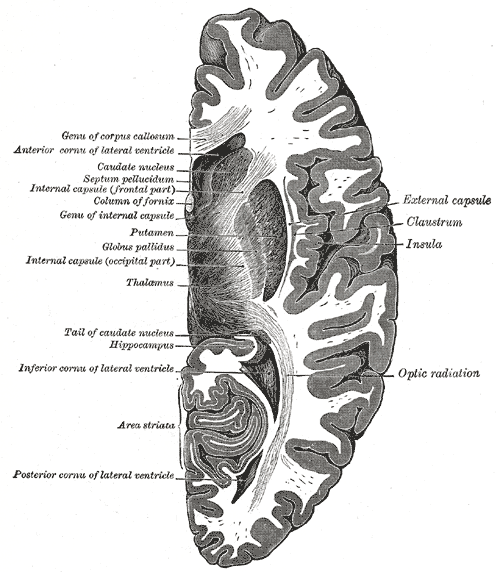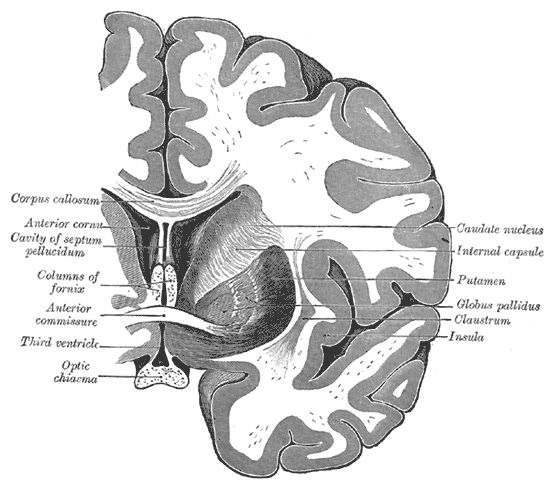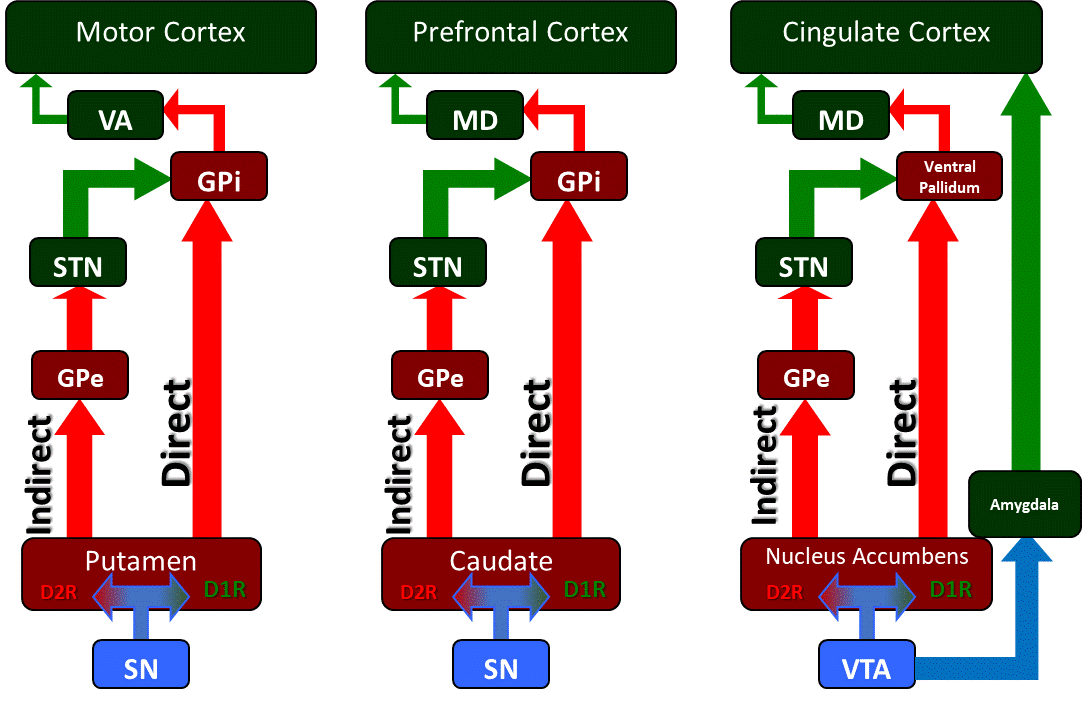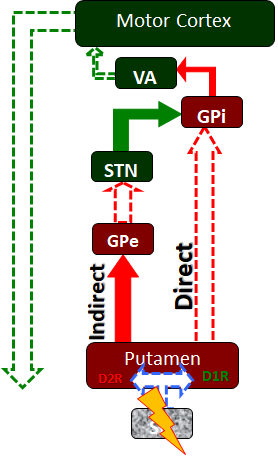[1]
Ide S, Kakeda S, Yoneda T, Moriya J, Watanabe K, Ogasawara A, Futatsuya K, Ohnari N, Sato T, Hiai Y, Matsuyama A, Fujiwara H, Hisaoka M, Korogi Y. Internal Structures of the Globus Pallidus in Patients with Parkinson's Disease: Evaluation with Phase Difference-enhanced Imaging. Magnetic resonance in medical sciences : MRMS : an official journal of Japan Society of Magnetic Resonance in Medicine. 2017 Oct 10:16(4):304-310. doi: 10.2463/mrms.mp.2015-0091. Epub 2016 Dec 22
[PubMed PMID: 28003623]
[3]
Lanciego JL, Luquin N, Obeso JA. Functional neuroanatomy of the basal ganglia. Cold Spring Harbor perspectives in medicine. 2012 Dec 1:2(12):a009621. doi: 10.1101/cshperspect.a009621. Epub 2012 Dec 1
[PubMed PMID: 23071379]
Level 3 (low-level) evidence
[4]
Voytek B, Emergent basal ganglia pathology within computational models. The Journal of neuroscience : the official journal of the Society for Neuroscience. 2006 Jul 12;
[PubMed PMID: 16838428]
[5]
Song DD, Harlan RE. The development of enkephalin and substance P neurons in the basal ganglia: insights into neostriatal compartments and the extended amygdala. Brain research. Developmental brain research. 1994 Dec 16:83(2):247-61
[PubMed PMID: 7535204]
[6]
Lo DC, Hughes RE, Paulson HL, Albin RL. Huntington’s Disease: Clinical Features and Routes to Therapy. Neurobiology of Huntington's Disease: Applications to Drug Discovery. 2011:():
[PubMed PMID: 21882418]
[7]
Steiner H, Gerfen CR. Role of dynorphin and enkephalin in the regulation of striatal output pathways and behavior. Experimental brain research. 1998 Nov:123(1-2):60-76
[PubMed PMID: 9835393]
[9]
Fazl A, Fleisher J. Anatomy, Physiology, and Clinical Syndromes of the Basal Ganglia: A Brief Review. Seminars in pediatric neurology. 2018 Apr:25():2-9. doi: 10.1016/j.spen.2017.12.005. Epub 2017 Dec 27
[PubMed PMID: 29735113]
[10]
Vasović L, Ugrenović S, Jovanović I. Human fetal medial striate artery or artery of Heubner. Journal of neurosurgery. Pediatrics. 2009 Apr:3(4):296-301. doi: 10.3171/2008.12.PEDS08258. Epub
[PubMed PMID: 19338407]
[11]
Djulejić V, Marinković S, Georgievski B, Stijak L, Aksić M, Puškaš L, Milić I. Clinical significance of blood supply to the internal capsule and basal ganglia. Journal of clinical neuroscience : official journal of the Neurosurgical Society of Australasia. 2016 Mar:25():19-26. doi: 10.1016/j.jocn.2015.04.034. Epub 2015 Nov 16
[PubMed PMID: 26596401]
[12]
Ribas EC, Yağmurlu K, de Oliveira E, Ribas GC, Rhoton A. Microsurgical anatomy of the central core of the brain. Journal of neurosurgery. 2018 Sep:129(3):752-769. doi: 10.3171/2017.5.JNS162897. Epub 2017 Dec 22
[PubMed PMID: 29271710]
[13]
Da Mesquita S, Fu Z, Kipnis J. The Meningeal Lymphatic System: A New Player in Neurophysiology. Neuron. 2018 Oct 24:100(2):375-388. doi: 10.1016/j.neuron.2018.09.022. Epub
[PubMed PMID: 30359603]
[14]
Sun BL, Wang LH, Yang T, Sun JY, Mao LL, Yang MF, Yuan H, Colvin RA, Yang XY. Lymphatic drainage system of the brain: A novel target for intervention of neurological diseases. Progress in neurobiology. 2018 Apr-May:163-164():118-143. doi: 10.1016/j.pneurobio.2017.08.007. Epub 2017 Sep 10
[PubMed PMID: 28903061]
[15]
Naganawa S, Nakane T, Kawai H, Taoka T. Differences in Signal Intensity and Enhancement on MR Images of the Perivascular Spaces in the Basal Ganglia versus Those in White Matter. Magnetic resonance in medical sciences : MRMS : an official journal of Japan Society of Magnetic Resonance in Medicine. 2018 Oct 10:17(4):301-307. doi: 10.2463/mrms.mp.2017-0137. Epub 2018 Jan 18
[PubMed PMID: 29343658]
[16]
Miyachi S. [Cortico-basal ganglia circuits--parallel closed loops and convergent/divergent connections]. Brain and nerve = Shinkei kenkyu no shinpo. 2009 Apr:61(4):351-9
[PubMed PMID: 19378804]
[17]
Carne RP, Vogrin S, Litewka L, Cook MJ. Cerebral cortex: an MRI-based study of volume and variance with age and sex. Journal of clinical neuroscience : official journal of the Neurosurgical Society of Australasia. 2006 Jan:13(1):60-72
[PubMed PMID: 16410199]
[18]
Giedd JN, Snell JW, Lange N, Rajapakse JC, Casey BJ, Kozuch PL, Vaituzis AC, Vauss YC, Hamburger SD, Kaysen D, Rapoport JL. Quantitative magnetic resonance imaging of human brain development: ages 4-18. Cerebral cortex (New York, N.Y. : 1991). 1996 Jul-Aug:6(4):551-60
[PubMed PMID: 8670681]
Level 3 (low-level) evidence
[19]
Szabó CA, Lancaster JL, Xiong J, Cook C, Fox P. MR imaging volumetry of subcortical structures and cerebellar hemispheres in normal persons. AJNR. American journal of neuroradiology. 2003 Apr:24(4):644-7
[PubMed PMID: 12695196]
[20]
Murphy DG, DeCarli C, Schapiro MB, Rapoport SI, Horwitz B. Age-related differences in volumes of subcortical nuclei, brain matter, and cerebrospinal fluid in healthy men as measured with magnetic resonance imaging. Archives of neurology. 1992 Aug:49(8):839-45
[PubMed PMID: 1343082]
[21]
Cury RG, Kalia SK, Shah BB, Jimenez-Shahed J, Prashanth LK, Moro E. Surgical treatment of dystonia. Expert review of neurotherapeutics. 2018 Jun:18(6):477-492. doi: 10.1080/14737175.2018.1478288. Epub 2018 May 28
[PubMed PMID: 29781334]
[22]
Hedera P. Treatment of Wilson's disease motor complications with deep brain stimulation. Annals of the New York Academy of Sciences. 2014 May:1315():16-23. doi: 10.1111/nyas.12372. Epub 2014 Feb 18
[PubMed PMID: 24547944]
[23]
Ahn JH,Kim AR,Kim NKD,Park WY,Kim JS,Kim M,Park J,Lee JI,Cho JW,Cho KR,Youn J, The Effect of Globus Pallidus Interna Deep Brain Stimulation on a Dystonia Patient with the GNAL Mutation Compared to Patients with DYT1 and DYT6. Journal of movement disorders. 2019 May;
[PubMed PMID: 31158945]
[24]
Combs HL, Folley BS, Berry DT, Segerstrom SC, Han DY, Anderson-Mooney AJ, Walls BD, van Horne C. Cognition and Depression Following Deep Brain Stimulation of the Subthalamic Nucleus and Globus Pallidus Pars Internus in Parkinson's Disease: A Meta-Analysis. Neuropsychology review. 2015 Dec:25(4):439-54. doi: 10.1007/s11065-015-9302-0. Epub 2015 Oct 12
[PubMed PMID: 26459361]
Level 1 (high-level) evidence
[25]
Azriel A, Farrand S, Di Biase M, Zalesky A, Lui E, Desmond P, Evans A, Awad M, Moscovici S, Velakoulis D, Bittar RG. Tractography-Guided Deep Brain Stimulation of the Anteromedial Globus Pallidus Internus for Refractory Obsessive-Compulsive Disorder: Case Report. Neurosurgery. 2020 Jun 1:86(6):E558-E563. doi: 10.1093/neuros/nyz285. Epub
[PubMed PMID: 31313803]
Level 3 (low-level) evidence
[26]
Oertel W, Schulz JB. Current and experimental treatments of Parkinson disease: A guide for neuroscientists. Journal of neurochemistry. 2016 Oct:139 Suppl 1():325-337. doi: 10.1111/jnc.13750. Epub 2016 Aug 30
[PubMed PMID: 27577098]
[27]
Syka M, Keller J, Klempíř J, Rulseh AM, Roth J, Jech R, Vorisek I, Vymazal J. Correlation between relaxometry and diffusion tensor imaging in the globus pallidus of Huntington's disease patients. PloS one. 2015:10(3):e0118907. doi: 10.1371/journal.pone.0118907. Epub 2015 Mar 17
[PubMed PMID: 25781024]
[28]
Alquist CR, McGoey R, Bastian F, Newman W 3rd. Bilateral globus pallidus lesions. The Journal of the Louisiana State Medical Society : official organ of the Louisiana State Medical Society. 2012 May-Jun:164(3):145-6
[PubMed PMID: 22866355]




